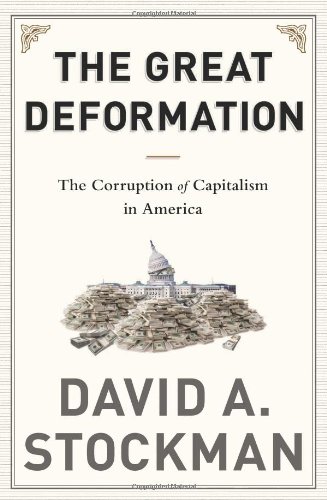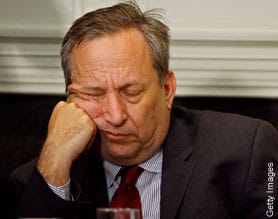This is going to be a review of David Stockman’s 768-page tome The Great Deformation, and 
although I never thought it was possible, it makes me angry to write this book review.
I’m not angry because I don’t like the book. On the contrary, this is the best economics book I’ve ever read. Indeed, it may be the best and most influential book I’ve ever read in my life. I only wish I had read it the moment it was published in April 2013. I only finished reading it today, and for the entire time I’ve been plowing through it, I’ve been trying to think of what I would say in this review.
Why am I angry, then, to write this? Bluntly stated, because nothing I can say will make what I want a reality. And what I want is for every literate person in the United States to read this book, cover to cover. I want them to read it. I want them to understand it. I want them to agitate for the changes that it recommends.
But I know at the outset that none of that is going to happen. The vast majority (I’ll pull a number out of the air and declare it as 90%) are too lazy, dim-witted, or apathetic to bother. And that 90%, I daresay, is a kind estimate. I would also wager that another 1% – – and that would be the fabled 1% which enjoy a storied existence at the top of the socioeconomic heap – – would be wholly irrational to embrace any of the core shifts that the book recommends. These elites, after all, are the beneficiaries of the madness elucidated therein.
Reagan’s Stockman
 Let’s back up. As those of you born before 1970 hopefully recall, David Stockman became nationally famous when, still in his mid-30s, he was made the budget director of the newly-elected Reagan White House. Stockman was front and center in national news for years, and I clearly remember, even as a young teenager, reading about Stockman and the battles he was waging to invoke the so-called Reaganomics. My general impression from that time was that he was smart, capable, and committed. Then, as of the mid-1980s, just like most of the rest of the nation, I stopped hearing about him.
Let’s back up. As those of you born before 1970 hopefully recall, David Stockman became nationally famous when, still in his mid-30s, he was made the budget director of the newly-elected Reagan White House. Stockman was front and center in national news for years, and I clearly remember, even as a young teenager, reading about Stockman and the battles he was waging to invoke the so-called Reaganomics. My general impression from that time was that he was smart, capable, and committed. Then, as of the mid-1980s, just like most of the rest of the nation, I stopped hearing about him.
I consider myself well-read, and I have the luxury of time to stay abreast of most financial and economic news. In spite of this, if you had asked me several months ago what had ever happened to David Stockman, I would have had absolutely no idea. I daresay most of you are in the same boat, so in brief, I’ll bring you up to speed:
After leaving the Reagan administration, Stockman joined Salomon Brothers and later was one of the earliest partners of the Blackstone Group. Years later, he went on to found his own private equity firm, Heartland Industrial Partners, for which he initially raised well over a billion dollars.
Heartland executed over twenty deals, one of which – Collins & Aikman – filed for bankruptcy. Stockman served as CEO at Collins, and early in 2007, he became the target of federal prosecutors in Manhattan as well as the SEC. From the little I’ve read about this period, the charges were completely ludicrous, and after wrecking nearly two years of Stockman’s life (as well as those of many others), the prosecutors dropped the entire fleet of charges well before a trial could even commence.
From what I can gather, Stockman’s mounting of his defense during the period of his prosecution was his come-to-Jesus moment, since it dawned on him the nature of the business game he had been playing for so many years. Specifically, the hazards of the debt-saturated private equity world and, much more broadly, the entire globe that had become utterly besotted by debt. Stockman writes:
At length, I saw the light, and it had nothing to do with Paulson’s apparent illiteracy on the precepts of sound fiscal policy. The bailouts, the Fed’s frenzied money printing, the embrace of primitive Keynesian tax stimulus by a Republican White House amounted to something terrible: a de facto coup d’etat by Wall Street, resulting in Washington’s embrace of any expedient necessary to keep the financial bubble going – and no matter how offensive it was to every historic principle of free markets, sound money, and fiscal rectitude.
Stockman thus endeavored to put together this book that is fervent, passionate, articulate, and remarkable in scope. And I kept wondering to myself, if the villains in the book (Paulson, Bernanke, Obama, the corpse of Richard Nixon, Larry Summers, Yellen, etc.) actually read it, would they think to themselves (A) “Oh my God, what have I done?????” or (B) “Crap, they’re on to us.”
Notable Quotes
My copy of the book is highlighted as heavily as the Bible of a Southern Baptist preacher, so it’s hard for me to “boil down” the book to anything less than a fifty page review. I will just share a few morsels that I think help capture some of the points Mr. Stockman wants to make and the elegant fashion in which he presents them:
“This was a blatant miscarriage of governance. As will be seen, at that late stage of the delirious financial bubble which had overtaken America, Goldman Sachs and Morgan Stanley had essentially become economic predators. Their bankruptcy would have resulted in no measurable harm to the Main Street economy, and possibly some gain. It would have also brought the curtains down on a generation of Wall Street speculators, and sent them packing in disgrace and amid massive personal losses – the only possible way to end the current repugnant regime of crony capitalist domination of the nation’s central bank.” (p. 22)
“In a healthy capitalist economy, income distribution reflects the economic justice of the marketplace, not the political engineering of the state, and properly so.” (p. 68)
“Policy measures like Fannie Mae, deposit insurance, social insurance, the Wagner Act, the farm programs, and monetary activism share a common disability: They fail to recognize that the state bears an inherent flaw that dwarfs the imperfections purported to afflict the free market; namely, that policies undertaken in the name of the public good inexorably become captured by special interests and crony capitalists who appropriate resources from society’s commons for their own private ends.” (p. 169)
“The Thomas Amendment was a nascent version of today’s delusion that economic setbacks, shortfalls, and disappointments are caused by too little money. The true cause, both in the early 1930s and today, was actually an excess of debt. This explanation is never appealing to politicians because there is no real cure for the liquidation of excess debt, except the passage of time and the forfeiture of the ill-gotten gains from the financial bubbles preceding it.” (p. 183)
It was around this time that I realized even sharing the very best of the best quotes, there would just be far too many, so I jumped toward the end of the book……
“The social insurance system is now entering an era of permanent funding crisis and chronic political turmoil. And, as detailed in chapter 32, the Bernanke stock market bubble is heading for a thundering meltdown which will vastly eclipse that of September 2008. So what lies ahead is endemic fiscal crisis, wrenching financial market dislocations, and relentlessly rising fear about financial security on Main Street.” (p. 648)
“Only a financial system addicted to and whipsawed by central bank money printing can produce such erratic, capricious, and correlated results. What is implicated here is not the doings of the free market but the corruption of free money. For that reason, the Greenspan axiom that financial bubbles can’t be prevented but only punctured and then bailed out afterward is downright perverse. Now in its third iteration, this policy is, in fact, the backstage mechanism by which society’s income and wealth are being redistributed to the top 1 percent.” (p. 656)
“While this is seemingly ironic given that Obama was reelected essentially on a platform of “fairness” for the middle class, that was content-free campaign rhetoric. The true irony is that political progressives are so indentured to Keynesian theories of demand stimulus that they have eagerly turned the nation’s central bank over to Wall Street lock, stock, and barrel.” (p. 657)
“The cruel corollary is that free market capitalism cannot help, either. It has been abused, burdened, demoralized, and impaired by decades of central bank money printing and the speculative raids and rent-seeking deformations which it fosters. Now the White House has a vague mandate that the 1 percent should pay more, but it’s too late. The coming crash will leave a lot less to tax.” (p. 671)
The Rogue’s Gallery
There are some definite “bad guys” (and bad events) skewered in these nearly 800 pages. The names are all known to you, but the deeds, and their details, are articulated in ways I didn’t understand well until now. These misfits include:
+ Richard “Tricky Dick” Nixon;
+ FDR (particularly his debasing of the dollar and confiscation of gold);
+ Alan Greenspan’s LTCM bailout in 1998;
+ Alan Greenspan’s panicked, rate-plunging response to the Internet bubble collapse;
+ Alan Greenspan’s deliberate inflation of the housing bubble (sense a trend here?);
+ Larry Summers, pictured here;
+ The military-industrial complex, wholly and utterly bloated beyond need;
+ Medicare/Medicaid/Obamacare and the breathtaking price inflation in the medical racket;
+ The “timorous” math professor Benjamin Bernanke;
+ The GM bailout, TARP package, and smorgasbord of “relief” programs in late 2008/early 2009
+ And, of course, President Obama
There are a few heroes mentioned in these pages, such as Fed chairman William McChesney Martin, Paul Volcker, Eisenhower, and Herbert Hoover (the last most particularly for the well-meaning, but aborted, efforts Hoover invoked to aid the nation as it entered Depression, only to be nefariously thwarted by a breathtakingly cynical FDR).
The Gospel?
Is this book absolutely perfect? Of course not. There are a smattering of typos and misspellings here and there, as one might expect of any book so large that could be used as a weapon of self-defense. It also is peppered with some phrases and expressions that get a bit overused or could be replaced with simpler language (for instance, “it cannot be gainsaid” could just as easily, and more clearly, be expressed by the word “undeniable.”)
It’s also on the long side, and it needn’t be quite so lengthy. I personally found a few of the chapters, particularly those oriented toward leveraged buyouts and private equity, to not add much to the polemic. Stockman knows these topics so deeply, it was probably tempting to spend extra time espousing them, not unlike the way I prattled on in my own recent book about the Silicon Valley’s Internet bubble.
But these trifles shave a hundredth of a point off the 100.00 score I would otherwise give the book. It is written with such clarity, fervor, and well-intentioned intellect that, even forty pages into it, I could hardly wait to climb my rooftop to tell the world to go buy it. Mr. Stockman’s days at the Harvard Divinity School have eased their way into the pages, because the prose reads like the fiery gospel of a true believer.
It goes without saying that these ideas and arguments are not the scribblings of a lunatic standing on the soapbox in Central Park. Stockman occupied the highest levels of government and finance for his entire working life, and he is a wealthy, famous, and well-connected man who could easily, along with the rest of his 1% brethren, rest comfortably on his laurels for the rest of his days. He chose instead to bring to the truth – – the bare, detailed, and important-to-understand truth – – to the rest of us.
What Needs to Be Done
The final chapter of Great Deformation is the powerful money-shot to the entire tome, but the potency is instantly and honestly neutered by the reality – which Stockman proclaims at the outset – that none of the stated cures will see the light of day. In a word, it’s simply too late, and only after a wrenching, worldwide financial cataclysm (that will make 2008 look like a gentle stroll with a lovely lass on a sunlit day) will humanity have the opportunity to get it right.
The last real opportunity to set things straight was presented – as Stockman writes – “on a silver platter” – but Washington doesn’t have an iota of the political will that would have been required to seize that opportunity. The America today, and particularly the 1%, are far too fat, happy, and accustomed to the easy way out to undergo such a thing.
Having said that, even though it will break your heart (or should break your heart) to read what has happened, what probably will happen, and what might have been, you owe it to yourself to read this book. America is too flabby to buck up and face reality, but you as an individual should at least take it upon yourself to understand better than 99% of your compatriots how we got here and what road lies ahead. Thank you, Mr. Stockman.

